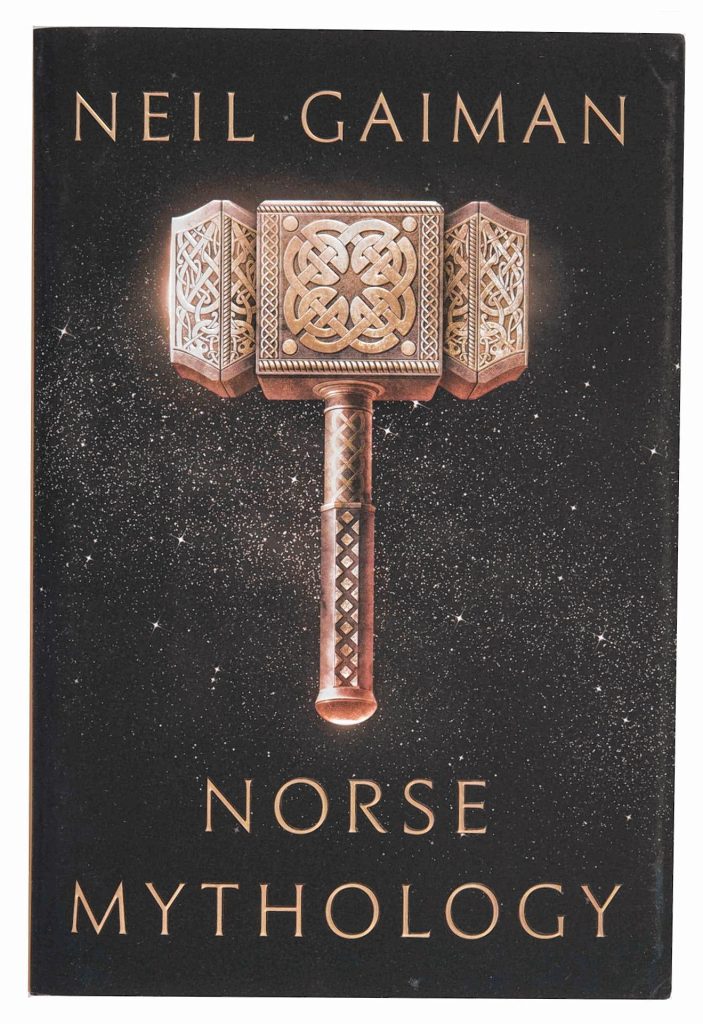Norse Mythology
By Neil Gaiman
(mythology, 2017)
In Norse Mythology, the inimitable Neil Gaiman once again earns his chops as a master of the fantastical. I listened to the audiobook version, narrated by Gaiman himself, and highly recommend that format for a particularly entertaining experience. Don’t confuse this 2017 release with the 2021-22 two-volume graphic novel adaptation of the same work. I haven’t seen the graphic novels yet (they’re on order for the Concord Public Library’s collection), so I’m hopeful but cannot yet speak to their quality.
I came to this collection with only the vaguest conceptions of the Norse pantheon. Fortunately, Mr. Gaiman’s writing makes these tales accessible to beginners like myself. In his introduction, Gaiman explains how he went about compiling and retelling these ancient tales, mostly using translated works by Scandinavian scholars as the source material. This book opens “before the beginning [when] there was nothing—no earth, no heavens, no stars, no sky; only the mist world, formless and shapeless, and the fire world, always burning.” For the next two hundred-or-so pages, Gaiman regales us with (mostly humorous, but sometimes violent or tragic) tales of Norse gods, goddesses, dwarves, giants, and humans. He closes with the telling of Ragnarok, the great future destruction and rebirth “when the few remaining people are living like animals, the sun in the sky will vanish, as if eaten by a wolf, and the moon will be taken from us too…” until the cycle re-sets and two people, Life and Life’s Yearning, emerge to repopulate the earth.
Everything in these stories is larger-than-life. The gods and goddesses constantly scheme amongst themselves, betray one another, and disguise themselves as humans to carry out clandestine missions. (For example, Thor, with his huge appetite, can polish off several oxen in a single meal—which leads to great comedic effect when he’s in disguise as a human and has to explain away his unorthodox dining habits.) Characters fly, shape-shift into animals, and regularly utilize magical objects and locations. Unlike the classical Greek myths with which I’m more familiar, these Norse tales don’t seem terribly concerned with explaining the source or nature of natural phenomena (a la “Did you ever wonder where…comes from?”). An exception is The Mead of Poets, where we learn “why some people make beautiful songs and poems and tales, and some of us do not.” The ending of that myth was, like many of Gaiman’s tellings, laugh-out-loud funny (and don’t even ask where bad poetry comes from!). Other favorites of mine were Freya’s Unusual Wedding and The Master Builder, where we learn how Loki became the mother of an eight-legged horse (yes, you read that correctly).
Again, if you have the opportunity to listen to Neil Gaiman reading this book aloud, I think it really enhances the experience. Gaiman proves to be an extremely talented voice artist, with an animated style and distinctive voices for all of the main characters. I appreciated hearing proper nouns (mostly people and place names) spoken aloud, since I’m not really up-to-snuff on my Scandinavian pronunciation. Many of these stories are whimsical or just plain funny—though, as I mentioned, this collection is certainly not short on battles or one-on-one violence. Gaiman does a good job finessing some of the racier content into a fairly PG format (e.g. “making love” happens, and is referred to as such.) All in all, this is an extremely entertaining listen, and is a great place to get started learning the major Scandinavian myths. In closing, please remember that this, and all books reviewed in the Concord Insider, fulfill the “recommended by staff” category of our 2022 Ultimate Book Nerd reading challenge!
Visit Concord Public Library online at concordpubliclibrary.net.
Faithe Miller Lakowicz









